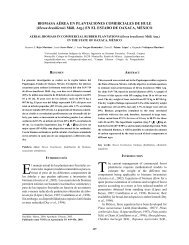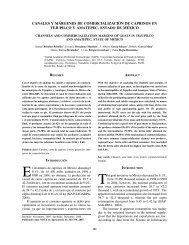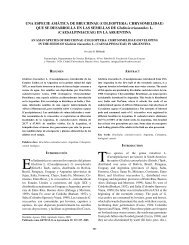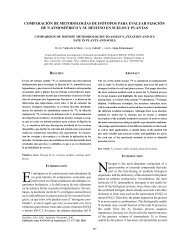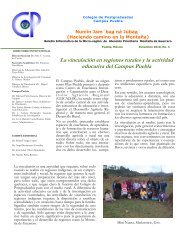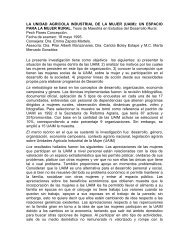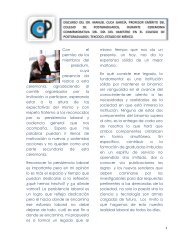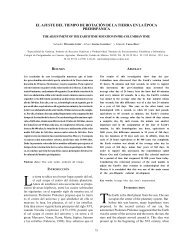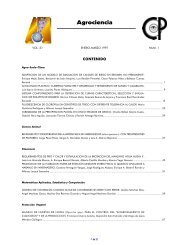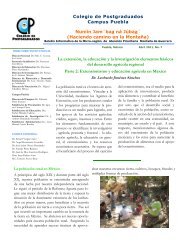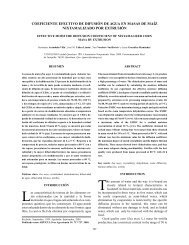AUTO-ACLAREO Y GUÍAS DE DENSIDAD PARA Pinus patula ...
AUTO-ACLAREO Y GUÍAS DE DENSIDAD PARA Pinus patula ...
AUTO-ACLAREO Y GUÍAS DE DENSIDAD PARA Pinus patula ...
Create successful ePaper yourself
Turn your PDF publications into a flip-book with our unique Google optimized e-Paper software.
<strong>AUTO</strong>-<strong>ACLAREO</strong> Y <strong>GUÍAS</strong> <strong>DE</strong> <strong>DE</strong>NSIDAD <strong>PARA</strong> <strong>Pinus</strong> <strong>patula</strong> MEDIANTE EL ENFOQUE <strong>DE</strong> REGRESIÓN <strong>DE</strong> FRONTERA ESTOCÁSTICA<br />
elaboraron guías de densidad para Hyeronima<br />
alchorneoides Allemão en Costa Rica y modificaron<br />
el valor del intercepto en el modelo de Reineke y<br />
Yoda para estimar el auto-aclareo. Estas metodologías<br />
son prácticas, pero resultan en un enfoque subjetivo<br />
para la estimación de la línea de auto-aclareo.<br />
Los modelos de RFE proveen una estimación<br />
directa y eficiente del límite superior del autoaclareo.<br />
Este límite representa la mayor cantidad<br />
de individuos que el rodal puede soportar de<br />
acuerdo a su diámetro cuadrático (Dq) o volumen<br />
promedio (Vp). En el modelo de Reineke, el ajuste<br />
Truncated-normal generó un intercepto mayor<br />
(12.106) respecto a MCO (12.002), pero<br />
menor al modelo Half-normal (12.430). Al sobreponer<br />
las líneas de auto-aclareo a los datos se<br />
observó un mejor comportamiento para el modelo<br />
Truncated-normal porque no existen datos que sobrepasen<br />
la frontera (Figura 1), aunque la varianza<br />
2<br />
del error (v 0.234) es relativamente más grande<br />
comparada con la varianza del error Half-normal<br />
2<br />
( v 0.127). Cummings et al. (2001) mencionan<br />
que un gran número de observaciones excederían<br />
la verdadera frontera y los resultados serían difíciles<br />
de interpretar. En el modelo Half-normal existen<br />
observaciones superiores a la frontera como resultado<br />
del error de medición, esto es, el primer componente<br />
de error (v). Aunque el modelo Half-normal<br />
presenta valores más bajos para el AIC y SchC respecto<br />
al modelo Truncated-normal, se eligió a este<br />
último para construir la guía de densidad dado su<br />
mejor comportamiento gráfico. Además, prácticamente<br />
coincide el IDR máximo (1655) encontrado<br />
en los rodales para un diámetro cuadrático de referencia<br />
de 20 cm, con el número de árboles estimado<br />
por el modelo de auto-aclareo (1662) cuando el<br />
Dq del rodal es de 20 cm.<br />
Para el modelo de Yoda el comportamiento de la<br />
trayectoria de las líneas de auto-aclareo sugiere que el<br />
modelo Half-normal se ajusta mejor a los datos (Figura<br />
2). Presenta un valor menor para el AIC y SchC,<br />
comparado con el modelo Truncated-normal y la<br />
2<br />
varianza del error Half-normal ( σv = 0. 044)<br />
es más<br />
pequeña que la varianza del error Truncated-normal<br />
2 ( σv = 0 235)<br />
. . Una varianza menor, junto con los<br />
errores estándar más reducidos de los parámetros del<br />
modelo son indicadores deseables para un mejor ajuste.<br />
La Figura 2 muestra observaciones que exceden la<br />
component (v). Although the Half-normal model<br />
showed lower values for AIC and SchC regarding<br />
the Truncated-normal model, we selected the latter<br />
to build the density guide, given their best graph<br />
performance. Furthermore, the maximum SDI<br />
found in the stands virtually coincides (1655) in<br />
relation to a 20 cm quadratic reference diameter<br />
with the number of trees estimated by the selfthinning<br />
model (1662) when the stand Dq is 20 cm.<br />
For the Yoda model, the behavior of the selfthinning<br />
lines trajectory suggests that the Half-normal<br />
model fits the data best (Figure 2). It has a lower<br />
value for AIC and SchC compared to the Truncatednormal<br />
model, and the Half-normal variance error<br />
2 ( σv = 0 044)<br />
. is smaller than the variance of the<br />
2<br />
Truncated-normal error ( σv = 0. 235)<br />
. A lower<br />
variance, together with smaller standard errors of<br />
the model parameters are desirable indicators for a<br />
better fitting. Figure 2 shows values which exceed<br />
the boundary marked by Half-normal, as expected<br />
in a stochastic frontier, but these are minimal. In<br />
contrast, in the Truncated-normal model, there are<br />
no data above this frontier, but it goes too far from<br />
the limit set by the data, which overestimates the<br />
true boundary. Due to this situation, in addition to<br />
statistical criteria, we chose the Half-normal model<br />
to build the density guide based on YDI.<br />
The slope of the self-thinning line of the models<br />
chosen was 1.5650.208 for Reineke (1933) and<br />
1.1990.048 for Yoda et al. (1963). In the case of<br />
Reineke, the 95 % confidence interval contains the<br />
value 1.605 empirically determined, while for Yoda<br />
the estimated slope is statistically far from the 1.5<br />
value. In particular, this result supports the conclusion<br />
presented by Del Rio et al. (2001), Pretzsch and Biber<br />
(2005) and Comeau et al. (2010) that the slope ()<br />
is not always close to the theoretical value and may<br />
differ significantly between species; therefore, the<br />
law of self-thinning cannot be generalized. The selfthinning<br />
model slope must be estimated with the data<br />
of each species and study region because populations<br />
have different mortality rates, depending on their<br />
density or growth habits. Even Zeide (1987) and Cao<br />
and Dean (2008) mentioned that the self-thinning<br />
line does not have a constant slope, but generally<br />
that line is curved. Thus, a realistic model of selfthinning<br />
should be inclusive rather than a law and<br />
reflect the change in canopy closure or gap dynamics.<br />
SANTIAGO-GARCÍA et al.<br />
85



